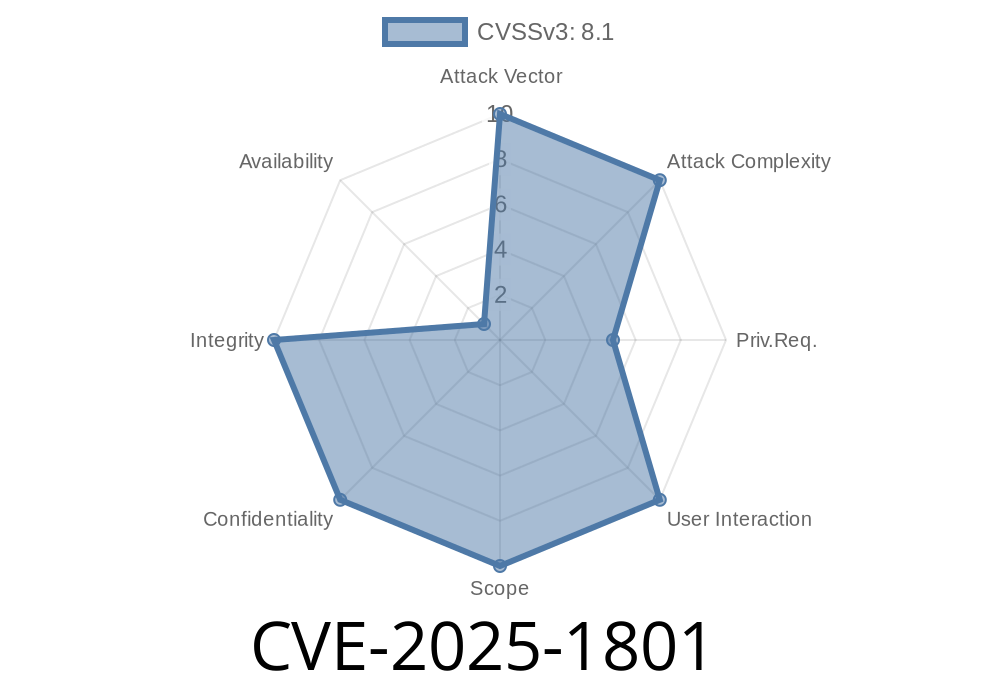#### June 2024 has seen the cybersecurity community alerted to a serious new vulnerability, CVE-2025-1801, affecting Ansible’s automation platform gateway (aap-gateway). This flaw could allow a lower privileged user to snatch the JWT token (used for authentication!) belonging to a higher-privileged user, potentially jeopardizing the entire server. In this post, I’ll break down how this happens, link to original references, provide code snippets to explain the underlying issue, and show an exploit sketch—all in plain language.
What is the Ansible AAP Gateway?
The Ansible Automation Platform gateway provides a gRPC-based proxy to manage requests among different services (usually for APIs and configs). This gateway acts as a middleman, ensuring secure forwarding of requests, and handles many user sessions and permissions at once.
What’s Actually Wrong: Race Condition & JWT Exposure
The gateway is designed to manage concurrent requests by different users. Unfortunately, it doesn’t handle certain concurrency scenarios correctly, which means that if two users (one more privileged than the other) make requests almost simultaneously, there’s a rare chance the lower privileged user could receive the JWT token intended for the higher privileged user.
#### This is called a “race condition”—two threads using the same resources at the same time, leading to unpredictable results.
What the Code Looks Like (Simplified Example)
Below is a simplified illustration of how a race condition might occur. Imagine a function mishandles user sessions like this:
class GatewayProxy:
current_jwt = None
def handle_request(self, user):
# User's JWT gets assigned to shared memory (bad idea!)
GatewayProxy.current_jwt = user.jwt
# Some proxy work happens here...
result = self.proxy_work()
# Use the JWT for authentication
authenticated = self.authenticate(GatewayProxy.current_jwt)
return authenticated
# ...rest of the class omitted
If two users hit the gateway nearly at the same time, the current_jwt could end up being swapped or overwritten—so one user receives the other's JWT as a response or in metadata.
This is classic race condition behavior.
Here’s a step-by-step breakdown of how an attacker might exploit CVE-2025-1801
1. Monitor Traffic: The attacker (with lower privileges) waits for a privileged user (like an admin) to make a request.
2. Trigger Concurrent Requests: When the attacker sees activity, they quickly fire off a matching request to the gRPC gateway—timing is key.
3. Race the Request: Because of the race condition, their request is processed almost at the same time as the admin's, with badly synchronized JWT handling.
Receive Admin’s JWT: The attacker’s response now contains the admin’s JWT.
5. Reuse the Token: The attacker uses the stolen JWT to authenticate further requests—as if they were the admin.
Exploit Code Sketch (Python + gRPC)
Below is a mock snippet that shows how one might automate step 2. (Don’t use for evil! Use for testing/awareness.)
import grpc
import threading
def send_request(jwt):
# Establish connection and send a request with a given JWT
with grpc.insecure_channel('gateway-host:50051') as channel:
stub = GatewayStub(channel)
# Attach JWT in metadata
response = stub.SomeMethod(
RequestMessage(),
metadata=(('authorization', f'Bearer {jwt}'),))
print(response)
admin_jwt = 'fake-jwt-for-admin'
attacker_jwt = 'fake-jwt-for-attacker'
# Spawn two threads - attacker tries to overlap with admin
threads = [
threading.Thread(target=send_request, args=(admin_jwt,)),
threading.Thread(target=send_request, args=(attacker_jwt,))
]
for t in threads:
t.start()
for t in threads:
t.join()
If the race hits just right, attacker might grab the admin_jwt from the gateway’s response, thanks to the concurrency bug.
How to Fix
- Upgrade to Safe Version: Monitor the Red Hat Security Advisory and your vendor’s portal. Patch as soon as a fix is provided.
- Review Code for Thread-Safety: All session and token variables must be handled in a thread-local or request-scoped way.
References
- Ansible Security CVEs
- gRPC Thread Safety Guide
- OWASP Race Condition Cheat Sheet
Conclusion
CVE-2025-1801 is a particularly nasty flaw because it’s subtle and hard to catch—but the impact can be major. If you use Ansible Automation Platform, update as soon as fixes become available. Don’t ignore race conditions in credential-handling code!
Stay secure! If you found this post useful, please share or bookmark it, and always test in your own environment using safe, responsible proof-of-concept code.
Timeline
Published on: 03/03/2025 15:15:16 UTC
